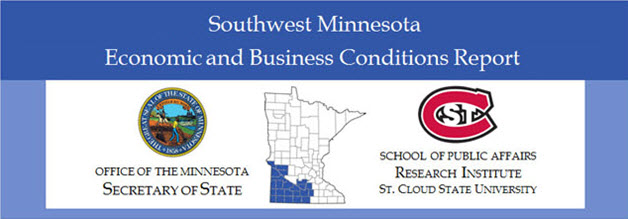Document Type
Research Study
Publication Date
6-2016
Abstract
Economic conditions are expected to improve in Southwest Minnesota over the next several months according to the predictions of the St. Cloud State University (SCSU) Southwest Minnesota Index of Leading Economic Indicators (LEI). A strengthening rural outlook, a recent increase in new business filings, and fewer initial jobless claims in the first quarter helped drive the leading index higher. A small reduction in residential building permits in Mankato served as a drag on the leading index in the first quarter.
There were 665 new business filings with the Office of the Minnesota Secretary of State in Southwest Minnesota in the first quarter of 2016 — representing 3.6 percent fewer new filings than one year earlier. There were 56 new regional business incorporations in the first quarter, a 9.7 percent decrease from one year ago. New LLC filings in Southwest Minnesota fell by 3.5 percent—decreasing to 391 in the first quarter of 2016. New assumed names totaled 190 in the first quarter—2.1 percent fewer filings than in March 2015. There were twenty-eight new filings for Southwest Minnesota non-profits in the first quarter—one less than one year earlier.
Employment of Southwest Minnesota residents expanded by 0.7 percent over the year ending March 2016. 1,574 more Southwest Minnesota residents have jobs than did one year earlier. The regional unemployment rate was 4.9 percent in March, an increase from a 4.7 percent reading in March 2015. Initial claims for unemployment insurance fell by 152 from year-ago levels in March—an 11.4 percent decrease. The Southwest Minnesota labor force rose by 2,075 (a 0.9 percent increase) over the year ending March 2016 and regional job vacancies approached multi-year high levels. Southwest Minnesota bankruptcies inched a little higher in the first quarter of 2016.
There was mixed economic performance in the Mankato/North Mankato Metropolitan Statistical Area (MSA)—the largest market in Southwest Minnesota. On the positive side, average hourly earnings rose, employment increased, and the labor force expanded. However, this was offset by a decline in the length of the workweek, a lower value of residential building permits, higher initial jobless claims, a larger unemployment rate, and lower new business filings.
Recommended Citation
Banaian, King and MacDonald, Richard A., "Southwest Minnesota Economic and Business Conditions Report - First Quarter 2016" (2016). Southwest Minnesota Economic and Business Conditions Report. 9.
https://repository.stcloudstate.edu/qebcr_sw_mn/9




